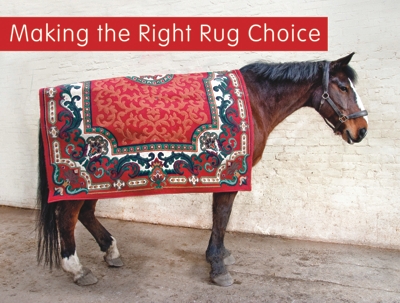To rug or not to rug.....
As autumn weather brings chillier temperatures, how many of you will put your hand under your horse's rug and think ‘ooh, nice and toasty warm’. So, to rug or not to rug - that is the question..... raised here by the British Horse Society North Region Team. Read on to find out if you're doing the right things for your horse.....

Yes, it may be nice to warm your hands up after mucking out, cleaning icy water buckets, filling nets - and all of the other 'fun' winter chores, but if your four legged friends could talk, they would probably be saying ‘we are way too warm’.
Horse owners in the UK can undoubtedly be a little bit barmy about rugs. We see the ‘must have’ new season colours, various weights (some almost heavier than the pony wearing them), indoor, outdoor, fleece, under blanket - the list goes on and on!
Deciding whether your horse or pony needs a rug can however be a complicated business, but if you follow a few simple steps, then hopefully everyone will be happy!
Firstly, you need to become familiar with the natural skin temperature of your horse. Whilst your horse is naked, place the palm of your hand on the hindquarters or neck and wait a few seconds, in order to help familiarise yourself with the temperature. There will be warmth, but almost undoubtedly it will feel a lot cooler than what you are used to experiencing under a rug.
When your horse has his rug on, place your hand underneath the rug and feel the shoulder. He/she shouldn’t feel any warmer than the temperature you familiarised yourself with. Any temperature above this will run the risk of overheating the horse, potentially causing it distress and at worst – to sweat.
Don’t assume a Thoroughbred needs more rugs or protection than a Clydesdale or a Cob; all horses have a different ability to regulate their body temperature and must be treated individually as a result. Given the choice, horses (even those wearing rugs) and other livestock, would seek shelter in inclement weather. A thick hedge, trees, a gully or a building all work well –but are sadly not always available on many holdings these days.
Most unclipped, heathy horses that are under cover overnight will not need a rug at all – especially if weather temperatures stay above zero and adequate forage supplies keep their internal furnace burning. The quality of the winter coat, type of stabling, whether it is draughty, how exposed the site is, type and depth of bedding etc, will all influence your decision. A cold horse may have a fluffy appearance as his coat is standing on end. A good guide is to feel the base of your horses’ ears (which should be warm). Horses will usually only shiver, if very cold, wet and windy conditions cause them to do so. Appropriate shelter in the field or a rug, will be needed to avoid this, as shivering is a miserable way to burn calories – for any mammal. If you do decide to clip your horse, make sure it is really necessary and avoid full clips if you can.
Is your horse in hard work? Is there a risk of your horse catching a chill whilst waiting to dry after exercise, or are they sweating a lot after exercise and losing too much weight as a result? If you answer yes to any of these questions, clip off hair accordingly to achieve the desired result. Avoid clipping ‘because it makes my horse look nice’ and bear in mind that after mid-January, clipping risks spoiling the summer coat which may be beginning to 'set'.
Some horses will be now be ‘casting’ their summer coat a little, in preparation for setting down a winter coat. Casting by the way, is the correct term to use here – the word ‘moulting’ applies to chickens and our other feathered friends! Just as in spring when the winter coat is casting, horses may be itchy at this time and it is important to regularly re-assess rugs whilst this happens and perhaps groom more regularly. Fully clipped horses will always need a rug to replace lost coat cover, however modern rugs and fleeces allow for layering, so that easy adjustment of the horse's clothing in order to manage their temperature is possible.
If you are putting rugs on your horses, make sure they fit properly and are secured correctly. The inner lining should always be dry and free of grease - you should also remove them daily for grooming, scratching and to check for sores, rubs and changes in body condition. Remember, rugged horses cannot groom each other, so if the sun does appear briefly – even in the depths of winter with snow on the ground - give your horses a chance to go rug-free for a short while; it will no doubt be greatly appreciated. Finally, if your horse is undressing itself or destroying rugs frequently – it could just be worth considering that he/she might be trying to tell you something….

The British Horse Society is the UK’s largest equestrian charity – working in Access and Rights of Way, Welfare, Safety and Education, in order to improve the lives of all horses.Our strength and influence stems directly from the support of our membership – join us at www.bhs.org.uk and help us continue to make a difference.
You can read this and lots more informative articles in the October issue of Equine magazine.
Subscribe securely online at The Equine Store, for secure online subscription.



